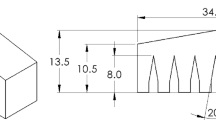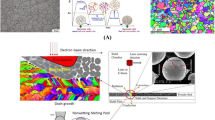Abstract
Cooling periods in the reflow soldering process significantly influence heat transfer coefficient and temperature distribution on solder joints, which constituently contribute to soldering defects. The domain of a desktop lead-free reflow oven was built based on the actual dimensions of a sample in GAMBIT 2.3.16. The model was exported to FLUENT 6.3.26 for further parametric study. After grid independency test, simulation results were validated by experimental data according to the American Society of Mechanical Engineers standard for computational fluid dynamics and heat transfer. Next, a simulation model was used to analyze the correlation between temperatures, heat transfer coefficient, and heat flux against reflow cooling durations. Results revealed that a very high radiation heat flux (122.760 W/m2) in a short cooling duration result in unmelted solder powders, which contribute to poor wetting. However, the reduced heat flux of 9.262 W/m2 affects the mechanical properties of solder balls with its continued cooling. Temperature variation and heat transfer coefficient on different points of the substrate are attributed to the non-uniform airflow distribution during the cooling stage. To sum up, the numerical investigation correlates temperature, heat transfer coefficient, and heat flux distribution on different reflow cooling periods to determine their effect on soldering quality.
















Similar content being viewed by others
References
Gao JG, Wu YP, Ding H, Wan NH (2008) Thermal profiling: a reflow process based on the heating factor. Solder Surf Mt Technol 20:20–27
Florian S, Denis K, Jörg F (2009) Influences on the reflow soldering process by components with specific thermal properties. Circuit World 35(3):35–42
Lau CS, Abdullah MZ, Che Ani F (2012) Computational fluid dynamic and thermal analysis for BGA assembly during forced convection reflow soldering process. Solder Surf Mt Technol 24(2):77–91
Salam B, Virseda C, Da H, Ekere NN, Durairaj R (2003) Reflow profile study of the Sn-Ag-Cu solder. Solder Surf Mt Technol 16(1):27–34
Tsai TN (2009) Modeling and optimization of reflow thermal profiling operation: a comparative study. J Chin Inst Ind Eng 26:480–492
Schußler F, Kozic D, Franke J (2009) Influences on the reflow soldering process by components with specific thermal properties. Circuit World 35(3):35–42
Lau CS, Abdullah MZ, Che Ani F (2012) Optimization modeling of the cooling stage of reflow soldering process for ball grid array package using the gray based Taguchi method. Microelectron Reliab 52(6):1143–1152
Lau CS, Abdullah MZ, Che Ani F (2012) Three-dimensional thermal investigations at board level in a reflow oven using thermal-coupling method. Solder Surf Mt Technol 24(3):167–182
Lee N-C (1999) Optimizing the reflow profile via defect mechanism analysis. Solder Surf Mt Technol 11(1):13–20
Hui IK, Ralph B (1995) A study of the initiation of the tombstoning effect on leadless chip. Int J Mach Tools Manuf 35(9):1251–1268
Lau CS, Abdullah MZ, Khor CY (2013) Optimization of the reflow soldering process with multiple quality characteristics in ball grid array packaging by using the grey-based Taguchi method. Microelectron Int 30(3):151–168
Lau CS, Abdullah MZ (2013) Simulation investigations on fluid/structure interaction in the reflow soldering process of board-level BGA Packaging. Int J Comput Theory Eng 5(4):645–649
V 20 Committee (2009) Standard for verification and validation in computational fluid dynamics and heat transfer. American Society of Mechanical Engineers, New York
Bejan A (1993) Heat transfer. Wiley, Canada
Eckert ERG, Robert M, Drake JR (1972) Analysis of heat and mass transfer. McGraw-Hill Inc, New York City
Fluent 6.3.26 (2006) User’s guide. Fluent Inc, Lebanon
Huang HL, Zhang H, Huang Y, Lu F (2007) Simulation calculation on solar chimney power plant system. In: International conference on power engineering, Hangzhou
Hussain S, Oosthuizen PH, Kalendar A (2012) Evaluation of various turbulence models for the prediction of the airflow and temperature distributions in atria. Energy Build 48:18–28
Lu X, Wang T (2013) Investigation of radiation models in entrained-flow coal gasification simulation. Int J Heat Mass Transf 67:377–392
Rek Z, Rudolf M, Zun I (2012) Application of CFD simulation in the development of a new generation heating oven. J Mech Eng 2:134–144
Chhanwal N, Anishaparvin A, Indrani D, Raghavarao KSMS, Anandharamakrishnan C (2010) Computational fluid dynamics (CFD) modeling of an electrical heating oven for bread-baking process. J Food Eng 100:452–460
Abtew M, Selvaduray G (2000) Lead-free solders in microelectronics. Mater Sci Eng 27:95–141
Yu H, Kivilathti J (2002) CFD modelling of the flow field inside a reflow oven. Solder Surf Mt Technol 14:38–44
Chavali S, Singh Y, Subbarayan G, Bansal A, Ahmad M (2013) Effect of pad surface finish and reflow cooling rate on the microstructure and the mechanical behavior of SnAgCu solder alloys. Microelectron Reliab 53:892–898
Acknowledgments
The author gratefully acknowledges the RED RING Solder (M) Sdn. Bhd. for providing the solder paste for this research.
Author information
Authors and Affiliations
Corresponding author
Rights and permissions
About this article
Cite this article
Srivalli, C., Abdullah, M.Z. & Khor, C.Y. Numerical investigations on the effects of different cooling periods in reflow-soldering process. Heat Mass Transfer 51, 1413–1423 (2015). https://doi.org/10.1007/s00231-015-1506-6
Received:
Accepted:
Published:
Issue Date:
DOI: https://doi.org/10.1007/s00231-015-1506-6




